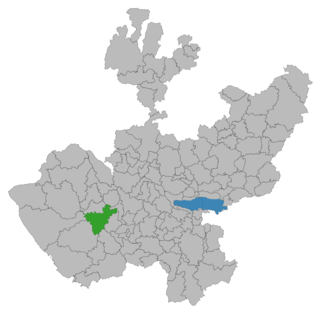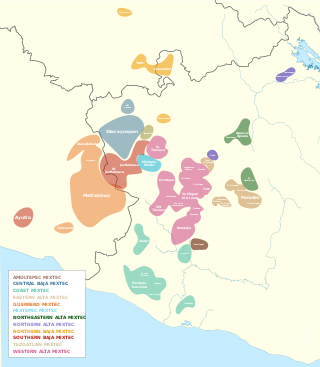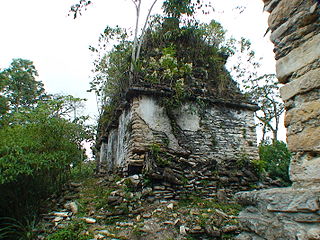Related Research Articles

The Mixtecs, or Mixtecos, are Indigenous Mesoamerican peoples of Mexico inhabiting the region known as La Mixteca of Oaxaca and Puebla as well as La Montaña Region and Costa Chica Regions of the state of Guerrero. The Mixtec culture was the main Mixtec civilization, which lasted from around 1500 BCE until being conquered by the Spanish in 1523.

The Mixtec languages belong to the Mixtecan group of the Oto-Manguean language family. Mixtec is spoken in Mexico and is closely related to Trique and Cuicatec. The varieties of Mixtec are spoken by over half a million people. Identifying how many Mixtec languages there are in this complex dialect continuum poses challenges at the level of linguistic theory. Depending on the criteria for distinguishing dialects from languages, there may be as few as a dozen or as many as fifty-three Mixtec languages.

Mixtec writing originated as a logographic writing system during the Post-Classic period in Mesoamerican history. Records of genealogy, historic events, and myths are found in the pre-Columbian Mixtec codices. The arrival of Europeans in 1520 AD caused changes in form, style, and the function of the Mixtec writings. Today these codices and other Mixtec writings are used as a source of ethnographic, linguistic, and historical information for scholars, and help to preserve the identity of the Mixtec people as migration and globalization introduce new cultural influences.
San Luis Acatlán is the seat of the municipality of San Luis Acatlán, located in the Mexican state of Guerrero. It is located in the Costa Chica region of the state, about 158 km from Acapulco. Most often called simply "Acatlán", the name comes from the locality of Acatlán located in the modern state of Puebla. The name itself derives from Nahuatl, meaning "among the reeds". Indigenous shepherds from Puebla arrived to this place between two rivers in Guerrero around 1750. San Luis derives from the name it was given in 1522 when soldiers of Pedro de Alvarado arrived here on this saint's day.

Ayutla de los Libres is a municipality in the Mexican state of Guerrero. The municipal seat lies at Ayutla de los Libres. The municipality covers an area of 735.4 km².
Cuajinicuilapa is a municipality in the Mexican state of Guerrero. The municipal seat lies at Cuajinicuilapa. The municipality covers an area of 857.1 km². In 2020, the municipality had a total population of 26,627, up from 25,537 in 2005.
Ayutla de los Libres is a city and seat of the municipality of Ayutla de los Libres, in the state of Guerrero, southern Mexico. As of 2010, its population was 15,370. The city of Ayulta de los Libres is the most populous in its municipality and accounts for about a quarter of the municipality's population.
Tlahuitoltepec Mixe, called South Highland Mixe in Wichmann (1995), is a Mixe language spoken in Mexico.

Ayutla is a town and municipality, in Jalisco in central-western Mexico. The municipality covers an area of 883.4 km².
Mixteca Alta Formative Project (2003–present) is an archaeological project directed by Andrew Balkansky that focuses on the Mixtec of Oaxaca, Mexico. The project, which is funded by the National Science Foundation, the National Geographic Society, and the H. John Heinz III Fund, seeks to understand Mixtec origins and their transition to urbanism. Excavations are currently taking place at the ancient site of Tayata.
MIY may refer to:

The internal classification of Mixtec is controversial. Many varieties are mutually unintelligible and by that criterion separate languages. In the 16th century, Spanish authorities recognized half a dozen lenguas comprising the Mixtec lengua. It is not clear to what extent these were distinct languages at the time. Regardless, the colonial disintegration of the Mixtec nation and resulting isolation of local communities led to the rapid diversification of local dialects into distinct languages. Below are some attempts at Mixtec classification by various scholars.
Silacayoapan is one of the more extensive Mixtec languages. It is spoken by 150,000 people in Puebla and across the border in Guerrero, as well as by emigrants to the United States.
Tilantongo (Diuxi-Tilantongo) Mixtec is a Mixtec language of Oaxaca. It is not close to other varieties of Mixtec. Numbers are declining due to emigration to the United States.
Tututepec Mixtec is a Mixtec language of Oaxaca, spoken in Santa María Acatepec, Santa Cruz Tututepec, San Pedro Tututepec and other towns. It is not close to other varieties of Mixtec.
Mixtepec Mixtec is a Mixtec language that is spoken in the lower Mixteca region. Mixtec language is largely spoken in the area of San Juan Mixtepec, district of Juxtlahuaca, state of Oaxaca. However, the language is also spoken in other areas including Tlaxiaco, San Quintín Baja California, Santa María California, and Oregon. In 2004, it was reported that approximately 12,000 people spoke the Mixtepec Mixtec language. While most speakers of the language refer to it as 'sa'an ntavi' meaning 'language of the poor' or 'poor people's language,' others refer to it as 'sa'an save' which means 'rain language.' It is not closely related to other varieties of Mixtec.
Chazumba Mixtec is a Mixtec language of Puebla and Oaxaca, spoken in the towns of Santiago Chazumba, San Pedro y San Pablo Tequixtepec, Zapotitlán, Santa Gertrudis Cosoltepec, Petlalcingo, and Totoltepec de Guerrero.
Southern Puebla Mixtec, denominated by INALI as Puebla-Oaxaca borderline Mixtec, and also known as Acatlán Mixtec, is a Mixtec language of Puebla and Oaxaca State in Mexico. It is spoken in the towns of Acatlán, Xayacatlán de Bravo, San Jerónimo Xayacatlán, Petlalcingo, and Zapotitlán Palmas.

Sak tzʼi is an archaeological site of the pre-Columbian Maya civilization. It is located in the municipality of Ocosingo of the Mexican state of Chiapas. The ruins are notable for having the earliest urban remains in the Upper Usumacinta region, as well as a unique ancient theater for elite use. The ancient identity of the site is subject to debate.
Ñuu Savi is a municipality in the Mexican state of Guerrero. It is located 85 kilometres (53 mi) southeast of the state capital of Chilpancingo. Its creation from the municipality of Ayutla de los Libres was approved in 2021 and went into force on 21 May 2022.
References
- ↑ Ayutla Mixtec at Ethnologue (18th ed., 2015) (subscription required)